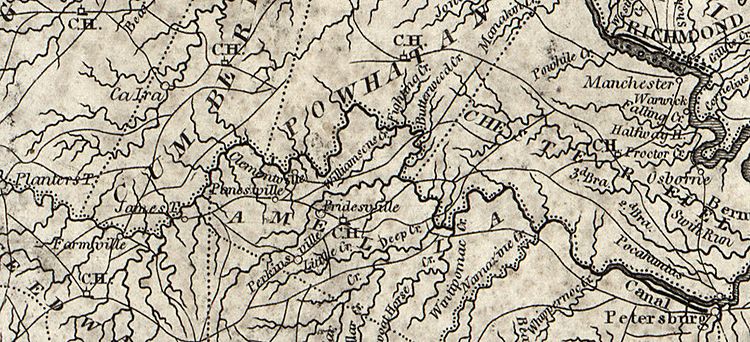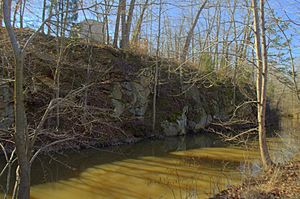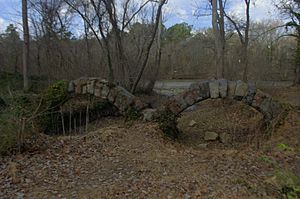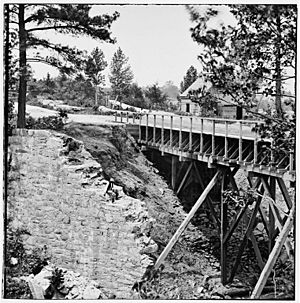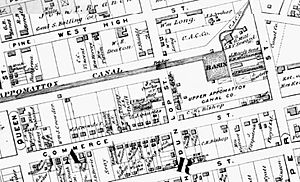Upper Appomattox Canal Navigation System facts for kids
The Upper Appomattox Canal Navigation system was a special waterway that helped farmers in Virginia move their crops like wheat and corn. From about 1745 to 1891, it allowed them to ship flour all the way from Farmville, Virginia to Petersburg, Virginia.
This system wasn't just one canal. It included changes to the Appomattox River, a canal built around the waterfalls near Petersburg, and a special turning area in Petersburg. Here, long, narrow boats could turn around. They would unload farm products from upstream and load up with goods made in Petersburg. From Petersburg, items could be sent on bigger ships to the Chesapeake Bay and beyond. People could also ride these boats for a fast and comfy trip. This river system was used for over 100 years!
Quick facts for kids Upper Appomattox Canal Navigation System |
|
|---|---|
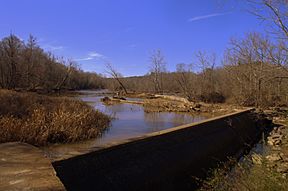
The Abutment Dam, the Appomattox Canal Dam, brought water to the Upper Appomattox Canal.
|
|
| Specifications | |
| Maximum boat beam | 5 ft 0 in (1.52 m) |
| Locks | 17 Locks (Staircase fashion around the Fall Line and along the river) |
| Status | No longer in use since 1890 |
| Navigation authority | Virginia General Assembly |
| History | |
| Original owner | Upper Appomattox Canal company |
| Principal engineer | John Couty (1830) |
| Date of act | 1796 |
| Construction began | 1809 |
| Date completed | 1816 |
| Date closed | 1890 |
| Geography | |
| Start point | Farmville, Virginia |
| End point | Petersburg, Virginia |
| Branch(es) | Appomattox River |
| Branch of | James River |
Contents
- History of the Canal System
- Early River Use: 1745
- The Upper Appomattox Company: 1795
- Building the Canal: 1816
- Israel Hill: A Community of Free People
- Canal Rebuilt: 1830
- Eppington Plantation
- Water Power from the Canal: 1850
- Civil War Damage: 1865
- Rebuilding After the War: 1872-1877
- After Reconstruction: 1877
- Competition from Railroads: 1891
- What Remains Today
History of the Canal System
The Appomattox River was changed to allow boats around 1745. It was improved many times over the years. Sadly, many parts of the canal system were built by enslaved people. Free Black people from a place called Israel Hill worked as boatmen. The canal was damaged during the American Civil War. It was used until faster trains became available.
Early River Use: 1745
By 1745, the Appomattox River was ready for "bateau" boats. These boats were long and narrow, about sixty feet long and six feet wide. They were designed to carry as much as possible through the river.
The Virginia General Assembly made laws to protect river travel. For example, a dam could not be built unless it also had special "locks" for boats to pass through.
The Upper Appomattox Company: 1795
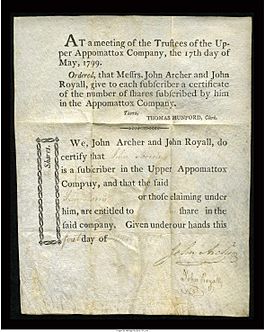
This is a stock certificate from the company.
|
|
| Public | |
| Founded | 1795 |
| Defunct | 1890 |
|
Area served
|
Farmville, Virginia to Petersburg, Virginia and Chesterfield, Amelia, Buckingham and Cumberland between. |
|
Key people
|
In 1799
|
In 1795, the Virginia General Assembly created the Upper Appomattox Company. The state even bought shares in the company to help it grow. In 1807, the company was allowed to sell bonds to help pay for building the canal.
A large dam, 335 feet long, was built in the Appomattox River. This dam sent water into the canal. The canal itself was built entirely by enslaved people who were owned by the company.
Building the Canal: 1816
The Appomattox Canal was finished in 1816. It stretched 5.5 miles from the waterfalls on the Appomattox River to a turning basin in Petersburg. Building it cost $60,000. The canal was wide enough for the bateau boats, about six feet wide and three feet deep.
With more money, the canal could carry even more river traffic. Enslaved people also improved the Appomattox River for over 100 miles from Farmville to Petersburg. They built many "wing dams" to keep the water flowing well. The river also had four stone "locks" that worked like staircases for boats. Some watermills along the river also had locks in their dams.
The canal around the waterfalls had a special "navigable aqueduct." This was like a bridge made of stone arches that carried boats over Rohoic Creek. Not far from the turning basin, there were deep water ports. These ports allowed goods to be shipped to and from the Chesapeake Bay and other places.
Israel Hill: A Community of Free People
About one-third of the bateau boats were owned by free Black people. Boats owned by white people also hired both white boatmen and free Black people, as well as enslaved people. A lot of the goods shipped from Farmville traveled on the Appomattox River.
In 1810, some enslaved people, including Sam White, were given land by Richard Randolph, who had freed them in 1796. They built a town on this land, farmed, and operated many of the boats on the Appomattox River. They transported goods for a fee. These free people continued to live there and work until the Emancipation Proclamation in 1863.
Canal Rebuilt: 1830
In 1829, the Virginia General Assembly hired an engineer. They wanted to see if the Appomattox River could be connected to the Roanoke River by canal or train. However, this connection was never built.
The Upper Appomattox Canal in Petersburg was rebuilt in 1830 by John Couty. It became a system with 17 locks and stretched for 8 miles. It was still designed for the bateau boats. Shippers paid tolls to help pay for keeping the locks and dams in good shape.
By 1831, boatmen were shipping huge amounts of goods. This included about 20,000 barrels of flour and 20,000 barrels of wheat. They also shipped tobacco, manufactured goods, cotton, corn, salt, and iron.
By 1836, Petersburg was connected to docks at City Point, Virginia by the City Point Railroad. This was faster than using carriages. Petersburg also got connected to other cities by train in the 1830s.
Eppington Plantation
The Epps Falls, near the Eppington Plantation, were dangerous for boats. In 1819, the General Assembly allowed the Upper Appomattox Canal company to build a dam and locks around these falls. The owner of Eppington, Archibald Thweatt, was paid for any damage. He and his family were also allowed to build a mill on the dam.
In the 1830s, Eppington Plantation had a warehouse and a dock. Farmers nearby could ship their products from these docks. When coal was first mined nearby in 1837, it was taken to the docks at Epps Falls. A boat carrying seven tons of coal could make a round trip to Petersburg in four days. This was soon replaced by the Clover Hill Railroad.
Water Power from the Canal: 1850
The water flowing from the canal basin powered many mills and factories. These mills made cotton, wool, and flour. The flour was even sent to places as far away as Brazil!
Civil War Damage: 1865
During the Siege of Petersburg in the American Civil War, the Confederate army tried to block the Union army. They built a large dam on Rohoic Creek. But the dam broke, and it washed away the aqueduct and a railroad line.
Rebuilding After the War: 1872-1877
After the Civil War, in 1872, the president of the Upper Appomattox Canal Company, W.E. Hinton, Jr., asked shareholders to help fix problems. The company had not been managed well. For example, they paid out money to shareholders before making needed repairs to the canal.
Senator Hinton was elected an officer in 1872. He got the right to sell bonds to raise money. This money was used to rebuild the aqueduct over Rohoic Creek. They also rebuilt a lock keeper's home, other buildings, and several locks and dams. The next year, the General Assembly allowed the company to sell more bonds to buy back company stock from the state.
After Reconstruction: 1877
After the Emancipation Proclamation and the end of the Reconstruction Era in 1877, the Virginia governor allowed the Upper Appomattox Canal company to use twenty to twenty-five prisoners for labor. This system, called "convict lease," meant that people, often Black men, were forced to work without pay. They were treated very harshly.
Competition from Railroads: 1891
The canal was used until the 1890s. By 1890, it faced strong competition from the Farmville and Powhatan Railroad. This railroad connected to the James River and other towns by 1891. Even though it was a narrow-gauge railroad, it could transport goods and people much faster than the canal, in just four hours. Railroads also offered lower prices due to competition. This made the canal less useful.
What Remains Today
Some of the old "wing dams" can still be seen in the river. The first few miles of the canal can be walked in Appomattox River Park in Petersburg. You can also see parts of the old aqueduct and other stone structures on the Appomattox River & Heritage Trail.
The straight part of the canal now follows Upper Appomattox Street. The turning basin was located where Dunlop Street, High Street, South Street, and Commerce Street meet today. The water used to flow down Canal Street back to the Appomattox River. Eppington Plantation is still in Chesterfield and is open to the public sometimes. Israel Hill has a historical marker in Farmville, Virginia.


